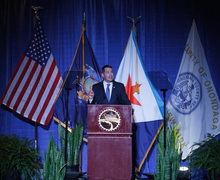How SU professor Rawiya Kameir interviews the biggest names in pop culture
Emily Steinberger | Photo Editor
Before joining the Newhouse School of Public Communications staff last fall, Rawiya Kameir profiled artists such as Tierra Whack, Davido and Noname for Pitchfork and The FADER.
Get the latest Syracuse news delivered right to your inbox.
Subscribe to our newsletter here.
The first time Rawiya Kameir spoke with Cardi B, the rapper was known for her posts on Vine, her time on the reality TV show “Love and Hip Hop” and her famous catchphrase, “okurrr.”
It was 2016, and Kameir was writing a profile of Cardi for The FADER, a lifestyle and music magazine. The next time the two would speak — in 2017, while meeting for lunch at Nobu in Manhattan — the up-and-coming rapper had found more success, and Kameir’s profile of Cardi would be The FADER’s cover story.
Though the artist had received more recognition from the music industry by the time they met up at Nobu, she was still Cardi, Kameir said.
“We just talked. It was really fascinating to see all the ways in which she had clearly grown, all of the things that were clearly different in her life,” Kameir said. “But then, on the other hand, she was completely the same person.”
Besides Cardi, Kameir has profiled rapper Tierra Whack, Afropop star Davido, rapper Noname and many other music artists through her role as a contributing editor at Pitchfork magazine and through her time at The FADER. And besides writing, she’s now an assistant teaching professor at the Newhouse School of Public Communications in the magazine, news and digital journalism department, a position she took on this fall.
Despite Kameir’s qualifications for the job, when the opportunity to work at Newhouse appeared, she thought the university wouldn’t pick her for the role. She always had the ambition to be a professor after watching both of her parents work in academia, but she had abandoned the dream after feeling culturally disconnected from her professors during her time at York University in Toronto.
Growing up, Kameir always loved music, and she would often read the liner notes inside of CDs and cassettes such as Mariah Carey’s “Daydream” and Wu-Tang Clan’s “36 Chambers” to learn behind-the-scenes details about the music. She originally saw herself working in the music industry, but having been born in Sudan and having grown up in Côte d’Ivoire, Tunisia and Egypt, she never really had access to “that world,” she said.
It wasn’t until she moved to Toronto for her undergraduate degree at York University that her life would revolve around music. All of a sudden, she was living in a city where she could attend concerts and get her hands on albums as soon as they dropped.
Even then, combining her passions for music and journalism to make a career as a music journalist was something that was just in the back of her mind. It wasn’t until she was getting her master’s degree at the Columbia University Graduate School of Journalism that she became more aware of how the music journalism industry worked.
Now, 11 years later, Kameir has received a nomination for the 2020 National Magazine Award in the essays and criticism category and has been featured in publications such as The New York Times and The Wall Street Journal.
But Kameir would never tell anyone that — not even Soo Yeon Hong, an assistant teaching professor at Newhouse, during her January 2020 interview for her current position. Kameir was all but silent on voicing her accomplishments.
“With some people, it’s all about what they did and how they try to impress you,” Hong said. “I didn’t even know she was a finalist for the Magazine Award. She never once bragged or said anything about her accomplishments even though she’s so young.”
Melissa Chessher, chair of the magazine, news and digital journalism department, worried during the hiring process that Newhouse may lose Kameir, as she had just been nominated for the National Magazine Award — “the highest honor you can receive in the magazine world,” Chessher said.
She basically has every skillMelissa Chessher, chair of MND department
As a teaching candidate, Kameir had to create a class presentation, which she chose to center around Beyoncé. Chessher remembers thinking that Kameir has to teach a class on the A-list artist, which she said will hopefully run in fall 2021.
“She basically has every skill,” Chessher said. “She, if we are lucky enough to keep her, will change us for the better and I just feel incredibly lucky that she’s here.”
But despite her accomplishments, Kameir said she’s an anxious person in general, which often makes the interviewing process nerve-wracking. She believes being introverted is common in the journalism field, as all of the things that make up a good journalist — such as empathy and compassion — are encapsulated in people who are nervous and overthink often.
When she speaks with high-profile celebrities, Kameir grounds herself by remembering that she doesn’t really care if the person likes her personally because she’s not there to be their friend. She also remembers that she’s there as a representative of the publication to do her job.
“I’m an introvert. I’m terrified of people in general, so whether I have to ask if there’s more oat milk in the back of the grocery store or if I have to ask LeBron James why he’s launching a tequila, it’s equally intimidating to me,” Kameir said.
Another way Kameir stays grounded is through the healing crystals she charges on the bookshelf in her downtown Syracuse apartment. As the world has grown more chaotic in the past year, Kameir uses not only crystals for their healing power but also mindfulness techniques such as journaling, yoga and meditation.
She often tries to understand the world through a lense of astrology — she’s a Capricorn, or, as she clarified, “the oldest sign in the Zodiac, which often means we’re the wisest.” While she doesn’t know what she 100% believes in, astrology is a way for her to have faith, just not in the religious sense.
“I’m just a person who likes to be introspective and try to be a kind contributor to the world,” Kameir said.
When Kameir made the decision to contribute to the world through teaching at Newhouse, her colleague and longtime friend Lakin Starling was not surprised.
Starling, who worked with Kameir at The FADER from 2016 to 2018 and is now a freelance journalist, said Kameir cares about cultivating people in very thoughtful and intentional ways. She has seen Kameir be such a resourceful person who brings new perspectives to her work and is “wonderful to learn from in and out of a classroom.”

Shannon Kirkpatrick | Presentation Director
“There are so many people that have benefitted from just being around Rawiya,” Starling said. “Whether it’s a conversation, whether it’s a casual encounter, there’s no way you could be around her and not take away something.”
Pitchfork senior editor Jillian Mapes felt intimidated by Kameir because of her accolades and success. The former New York University professor used to talk about Kameir’s Cardi B cover story in her classroom, and she wasn’t sure what to expect from the writer.
But to Mapes’ surprise, they spent their whole first lunch as colleagues at Pitchfork “shooting the sh*t” about the cooking show “Chopped.” From their chat, she quickly realized that Kameir was down-to-earth and “lowkey like a genius.”
Whenever there’s a cultural event or phenomenon that’s happening in real time, Kameir is the person she reaches out to to critically analyze the situation and how it ties into the larger culture as a whole.
“It’s amazing to have somebody that is literally maybe the best writer work with you regularly, and they’re one of the most humble people,” Mapes said.
And even with all the pieces she’s written, one stands out. In October, Kameir wrote about Toronto-based singer-songwriter Mustafa and his debut project “When Smoke Rises,” which deals with the rapper’s grief and mourning process.
Kameir believes that Mustafa is misunderstood and was grateful to be able to present different parts of his experience using her words, something that was a very moving experience for Kameir.
“And it’s not about me, it’s him, it’s his words, but to have been able to facilitate that and to have done that story as someone who knows more about him than just what his art is was very important to me personally,” Kameir said.
Published on February 24, 2021 at 9:34 pm
Contact Sydney: sabergan@syr.edu






